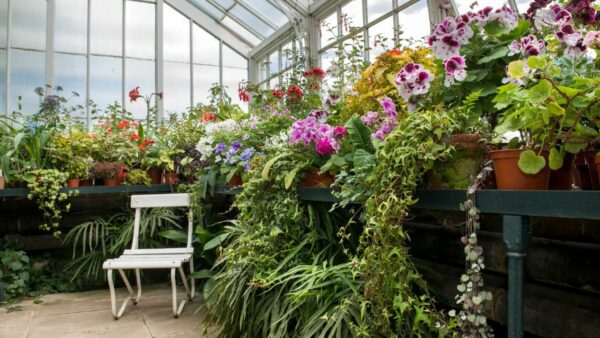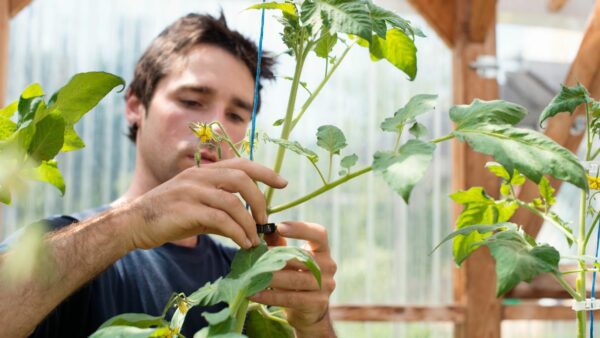Whether you have a green thumb that’s itching to expand its growing power and take gardening to the next level or you’re upping your preparedness efforts to become more self-reliant, an attached greenhouse may be the answer. Perhaps having your very own greenhouse has always felt like a distant dream that includes a structure reserved for the wealthy or for those with lots of extra lands. The truth is that a personal greenhouse can actually be quite affordable, especially if you build it yourself. Huge land parcels are not always necessary.

What Is an Attached Greenhouse?
You’re likely already familiar with what a greenhouse is: a structure in which various plants, fruit, and herbs can be grown throughout the year away from some of the season’s harsh elements. So what makes an attached greenhouse stand out from the rest? These greenhouses sometimes referred to as lean-tos, are attached to the side of an already existing house or other structure and generally share at least one wall with the other building.

7 Reasons to Build an Attached Greenhouse
There are innumerable reasons for, and benefits to, installing the addition of a greenhouse attached to your home. If you can envision yourself enjoying your own personal green paradise but still need a nudge to commit, check out these seven top reasons why you should draw up some plans, procure your materials, and gather up your tools ASAP.
1. It Solves Accessibility Issues
One of the largest drawbacks to a stand-alone greenhouse is the extra considerations and efforts that go into supplying it with all-important water and electricity. It’s a much simpler task to route these resources to your attached structure from your home which is right there and already equipped with water and power.
Outside of easy accessibility to the resources required to keep your greenhouse functioning and habitable for plant life, attaching your indoor gardening wonderland to your home also makes the space more accessible to you and anyone else who lives in your house. Its close proximity becomes a huge perk when it makes getting to your greenhouse and caring for it a cinch, especially when very in-climate weather threatens to otherwise deter you from heading out to a stand-alone model.
2. It Improves Home Heating
This is an advantage you’ll appreciate right away, particularly if you live in a cold climate. Depending on the location of your greenhouse, it will slowly warm up on clear days, even when the temperature is downright chilly outside. If your space has been designed with operable windows between your home and greenhouse, opening them after the space has reached at least 80 degrees will allow heat to flow into your home. This means you’ll be able to cut back on other energies used to heat the house, saving money and other costly resources.
Even if you don’t have windows between the two spaces, you’ll still enjoy the benefit of added insulation between your living space and the elements, which also helps to keep your living environment warmer.
3. Spend Less than on a Home Addition
If you’ve long hoped to enlarge your living space, why not also grow your garden? Choosing to install a greenhouse over a full-blown traditional home addition can protect your bank account. The cost of typical home addition is often as much as 40 percent more expensive than a greenhouse addition. Adding an attractive seating area will ensure that you spend plenty of time in the space, making it truly feel like an extension of your living area.
4. You Can Grow More Food
Becoming the proud owner of a greenhouse not only expands the space that you have for growing plants, fruits, and vegetables but also extends your growing season. If you live in a climate that’s always changing with the seasons, a greenhouse will allow you to continue to enjoy the fruits of your labor all year round.
5. Run Your Own Home Humidifier
If the air inside your home tends to become dryer during the winter months, an attached greenhouse can provide needed relief. The space can be a resource of humidity for your house, adding moisture into the air and returning your home to a comfortable living environment.
6. Increases Your Home Value
A greenhouse provides an attractive and unique look to a home, especially if the space has been laid out in such a way that it invites visitors to lounge and stay awhile. In this way, it increases the value and appeal of the house.
7. Customization of the Appearance of Your Home
The options are endless when it comes to adding a greenhouse to your home. You could choose to make the design flow with the existing look of your house and the surrounding environment, or you could choose a completely unique look that transforms and alters the appearance of your living space. This is your chance to create a space that you truly adore.
3 Benefits of Building Your Own Greenhouse

No products found.
Maybe you’ve always thought that the cost of a greenhouse made this a luxury that was out of your reach. You don’t have to spend an arm and a leg for an attached greenhouse. Particularly if you’re a die-hard DIYer, this is a structure you can build yourself, rather than relying on an outside builder or kit. This will save you when you do it yourself. Here are the benefits that you will get.
1. Building a Greenhouse is Cheaper
Don’t let the price tag keep you from your own personal greenhouse oasis. Plan and build it yourself to make your structure an affordable project. Shop salvage centers for supplies such as used windows first before buying new, ones to ensure additional savings.
2. You Can Decide Every Last Detail When Building Your Greenhouse
Drawing up and building your very own design ensures that your greenhouse looks and functions exactly how you would like it to. You choose every material, every color, and every last detail. This also gives you direct control over the money and resources put into your new green space.
3. Building a Greenhouse Isn’t Difficult or Time-Consuming
Even if you aren’t a master architect, it’s still within your reach to design and build an attached greenhouse. If it makes you more comfortable, and you have the financial means to do so, you can certainly consult a professional during any stage of your project. However, you can easily find ideas, inspiration, building blueprints, and design plans online.
Those who aren’t averse to DIY building projects could make this a weekend or multi-weekend activity. Supplies aren’t difficult to procure, with most of your needed building materials available at your local home improvement store or at used and salvaged building supply centers, should you choose to utilize them.
How to Build a Greenhouse in Your Garden: First 3 Steps
You’re no doubt excited to jump into the adventure of building your own attached greenhouse, but there are a few things to keep in mind before construction begins. With this guide, you will have your greenhouse done in no time.

No products found.
No products found.
1. Choose The Location of Your Greenhouse
You’ll often see it cited that the best location for your attached greenhouse is the south side of your home. While it’s true that structures built facing southward may better harness the sun’s rays, particularly during cold winter months, it’s acceptable to place it elsewhere if it works better for your housing setup. Also, keep in mind that cost savings will apply if you’re lucky enough to have an “L” in the perimeter of your home that the greenhouse can be nestled into. This would mean only needing to construct two walls rather than three.
No products found.
No products found.
2. Choose the Greenhouse’s Size
Don’t let the lack of a large space or sizeable resources hold you back from the building. Even if you only have a small plot of land to work with, the careful arrangement of tables and benches inside can provide adequate growing space in sizes as little as an eight-by-ten-foot area.
After determining the size of the greenhouse that you’ll construct, take into consideration the height of the ceiling. Although the typical tall conservatory-style greenhouse ceiling is stunning, it isn’t absolutely necessary unless you plan on growing some tropical plant varieties. Take into account your budget and space limitations before the building commences.
3. Choose Materials for Building Your Greenhouse
Consider your preferred materials for your project. Great options for the plant room floor include concrete or bricks. Concrete is an inexpensive choice for your flooring, while you may find bricks to be easier to lay albeit slightly more expensive. Gravel or cinders can also be used but should be thought of as more of a temporary set-up.
Wood varieties that are great for framing the structure of your greenhouse include cedar, redwood, Douglas fir, and cypress. Seasoned lumber can also be used if that’s the material that fits within your budget. Just keep in mind that all woods should be treated to protect them from rotting and warping.
Final Thoughts
Avid gardeners need not think of the addition of an attached greenhouse as being an unattainable and distant dream. Bring your aspirations of growing throughout the year to fruition through planning and building your very own lean-to-enclosed green space. Stretch your DIY muscle and your dollars to complete a building project that will bring you a host of year-round benefits and supply added beauty to your living space.
Katy Willis is a writer, lifelong homesteader, and master herbalist, master gardener, and canine nutritionist. Katy is a preparedness expert and modern homesteader practicing everyday preparedness, sustainability, and a holistic lifestyle.
She knows how important it is to be prepared for whatever life throws at you, because you just never know what's coming. And preparedness helps you give your family the best chance to thrive in any situation.
Katy is passionate about living naturally, growing food, keeping livestock, foraging, and making and using herbal remedies. Katy is an experienced herbalist and a member of the CMA (Complementary Medical Association).
Her preparedness skills go beyond just being "ready", she's ready to survive the initial disaster, and thrive afterward, too. She grows 100% organic food on roughly 15 acres and raises goats, chickens, and ducks. She also lovingly tends her orchard, where she grows many different fruit trees. And, because she likes to know exactly what she's feeding her family, she's a seasoned from-scratch cook and gluten-free baker.
Katy teaches foraging and environmental education classes, too, including self-sufficient living, modern homesteading, seed saving, and organic vegetable gardening.
Katy helps others learn forgotten skills, including basic survival skills and self-reliance.
She's been published on sites such as MSN, Angi, Home Advisor, Family Handyman, Wealth of Geeks, Readers Digest, and more.
Last update on 2024-07-27 at 04:13 / Affiliate links / Images from Amazon Product Advertising API

Thank you for this wonderful information!!! I have wanted an attached greenhouse for years but was never in one place long enough to bring it to reality. Now, retired and living in Northern Michigan, I’m ready to pursue this dream. Question; the purchased home already has vinyl siding on it, will I need to remove the vinyl siding to add the greenhouse? The greenhouse will be on the South side of my house which is where all the sun is. I am hoping to utilize it for growing most definitely, but also to help with the moisture and heating in my house. Thank you for any input, observations, instructions and advise you have for me.